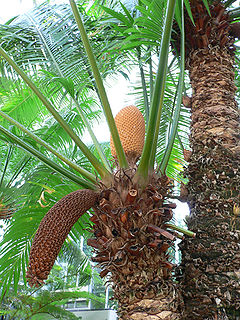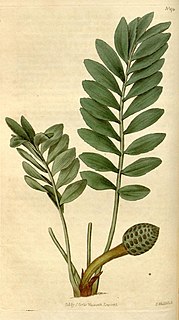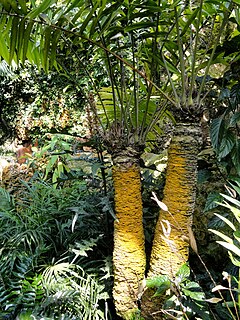
Cycadales is an order of seed plants that includes all the extant cycads. These plants typically have a stout and woody (ligneous) trunk with a crown of large evergreen leaves. They usually have pinnate leaves. The individual plants are either all male or all female (dioecious). Cycads vary in size from having trunks only a few centimeters to several meters tall. They typically grow very slowly and live very long, with some specimens known to be as much as 1,000 years old. Because of the superficial resemblance, they are sometimes confused with and mistaken for palms or ferns, but are only distantly related to either.

Zamia furfuracea is a cycad native to southeastern Veracruz state in eastern Mexico. Although not a palm tree (Arecaceae), its growth habit is superficially similar to a palm; therefore it is commonly known as cardboard palm or cardboard cycad. Other names include cardboard plant, cardboard sago, Jamaican sago, and Mexican cycad. The plant's binomial name comes from the Latin zamia, for "pine nut", and furfuracea, meaning "mealy" or "scurfy".

Zamia pumila, or coontie palm, is a small, tough, woody cycad of the West Indies. Zamia pumila was the first species described for the genus and hence is the type species for the genus Zamia and the family Zamiaceae.

The Zamiaceae are a family of cycads that are superficially palm or fern-like. They are divided into two subfamilies with eight genera and about 150 species in the tropical and subtropical regions of Africa, Australia and North and South America.

Zamia is a genus of cycad of the family Zamiaceae, native to Mexico, the West Indies, and Central and South America as far south as Bolivia. The range of one species (Z. integrifolia, extends into the contiguous United States, i.e. Georgia and Florida.

Zamia fischeri is a species of cycad in the family Zamiaceae. It is endemic to Mexico. It is often confused with Zamia vazquezii. Zamia fischeri is named after Gustav Fischer, a cycad enthusiast of the nineteenth century.

Zamia pseudoparasitica is a species of plant in the family Zamiaceae. It is endemic to Panama. Its natural habitat is subtropical or tropical moist lowland forests on the Atlantic side of the isthmus. It is threatened by habitat loss.

Zamia pygmaea is a species of plant in the family Zamiaceae found only in Cuba. It is the smallest living cycad. It is listed as critically endangered on the IUCN Red List based on its limited distribution, severely fragmented habitat, and population of less than 250 mature individuals.
Florida arrowroot was the commercial name of an edible starch extracted from Zamia integrifolia (coontie), a small cycad native to North America.
Zamia staggers is a fatal nervous disease affecting cattle where they browse on the leaves or fruit of cycads—in particular, those of the genus Zamia. It is characterised by irreversible paralysis of the hind legs because of the degeneration of the spinal cord. It is caused by the toxins cycasin and macrozamin, β-glycosides of methylazoxymethanol (MAM), and which are found in all cycad genera.

Cycasin is a carcinogenic and neurotoxic glucoside found in cycads such as Cycas revoluta and Zamia pumila. Symptoms of poisoning include vomiting, diarrhea, weakness, seizures, and hepatoxicity. In metabolic conditions, cycasin is hydrolyzed into glucose and methylazoxymethanol (MAM), the latter of which dissociates into formaldehyde and diazomethane.

Zamia lindenii is a species of cycad in the family Zamiaceae.
Zamia nesophila is a species of cycad in the family Zamiaceae. It originates from Western Panama.
Zamia restrepoi is a species of cycad in the family Zamiaceae.
Zamia sandovalii is a species of cycad in the family Zamiaceae.
Zamia stricta is a species of cycad in the family Zamiaceae.
Zamia huilensis is a species of cycad in the family Zamiaceae.
Zamia stevensonii is a species of cycad in the family Zamiaceae.

Zamia integrifolia is a small, tough, woody cycad native to the southeast United States, the Bahamas, Cuba, the Cayman Islands, Hispaniola, and Puerto Rico. The species is possibly extinct in Puerto Rico and Haiti.










